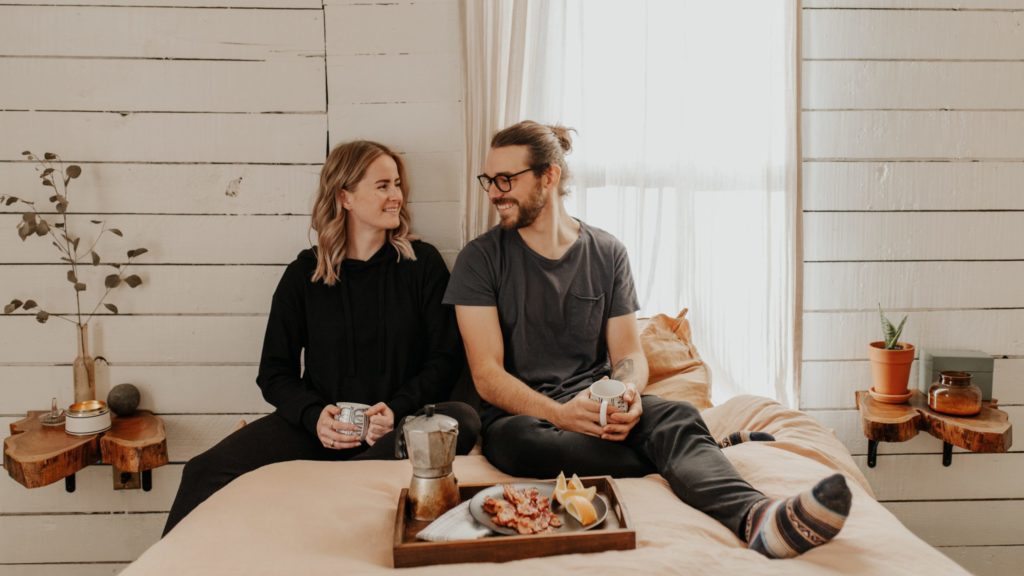A few years back, I developed an obsession with the Pottery Barn catalogue. I’d spend evenings with it, memorizing the spreads, fantasizing about the day I could buy one of their $2,000 cranberry sofas to replace our mismatched hand-me-downs. Some part of me believed that cash translated to cozy, that I could buy my way home.
Apparently, I am not alone. According to Daniel Pink’s book, A Whole New Mind, ambiance is an increasingly hot commodity. Take lighting, for example. Electricity is relatively cheap and widely available, yet each year Americans spend more than $2.4 billion on candles. Pink believes candles are big business “for reasons that stretch beyond the logical need for luminosity to a prosperous nation’s inchoate desire for beauty and transcendence.”
These desires also translate into a deluge of information. I recently came across Cheryl Mendelson’s 896-page book Home Comforts, which begins with her confession: “I am a working woman with a secret life: I keep house.” She then goes on to detail every dilemma a homemaker might encounter, from what laundry temperature our whites require to how to exist peacefully with microbes.
I’m not in Mendelson’s league when it comes to housework. The first time we moved, I forgot to empty the grounds in the coffeepot, and when we reached Portland, the soggy grounds resembled a stinky green sea anemone. By the time we left Oregon, four years later, we had accumulated a closet of newspapers. On that last night, as the clock struck twelve, we were standing on our exterior porch, chucking armloads of newspapers into the recycling bin below.
Generally speaking, domestication has not come naturally, which may be why Victoria Moran’s Shelter for the Spirit captured me. Moran doesn’t buy into the retail myth: she believes that making a home is about learning to live faithfully in your space, ordering your environment in a serene and hospitable way. She explores the spiritual dimensions of homemaking, manifest in the concrete, everyday details like cleaning, cooking and entertaining. The book isn’t explicitly Christian, but the work as a whole was an epiphany for me.
According to Moran, we need not wait until we own homes to begin the work of homemaking. “This is your home,” she writes, “Whether you own it, rent it, or were born into it. Home is where you go to refuel — physically, emotionally and spiritually. You no more need to own the house for this personal refueling than you need to own the service station to get gas.” Here are a few basic tips for turning your dwelling space — be it high rise apartment, chrome trailer or bungalow — into a home.
Seeing What’s There
I’m always tempted to see what isn’t there instead of what is. I think this temptation is common, and is experienced both materially and relationally. We may say to ourselves, “I’ll make a home when I get married or when we have a child or when we finally own a house.”
Moran offers this word of caution: “Between the desire and fulfillment, there may be days or years of living. If you believe that having a ‘real home’ depends on having someone or something you don’t have, you deny yourself much of the joy available in your home today.”
The work of making a home begins with the simple act of learning to see what you already have — asking God to open your eyes to the unique blessings of your space, be it the way the afternoon light spills onto your reading chair, the breeze that comes into your bedroom windows, the sound and scent of coffee brewing in the morning. All these things are part of grace you inhabit now.
Keep it Tidy
It is impossible to fully see what you have when your sink is overflowing with two weeks’ worth of dishes. Years ago a friend of mine introduced me to “Good Enough Housekeeping.” This concept protects me from Martha Stewart burn-out. I have fairly modest goals for myself with rewards built in to them. For example, just before I sit down at my computer, I start a pot of coffee. While the pot is brewing, I race around the house doing a quick pick-up. I only allow myself to clean until the coffee pot beeps. Then I sit down to work in a tidy space with my steaming mug of java.
I never thought I’d admit this (and my mother might email my editor contesting this next statement) but I’m starting to enjoy the simple work of wiping down the counter, loading the dishwasher and making the beds. This mindless work can be soothing and prayerful. I understand, now, why monks and nuns don’t spend all their time praying in church. They weed the fields and chop carrots in the kitchen not just for physical nourishment, but for spiritual nourishment as well. “In the mud and scum of things,” Emerson wrote, “Always something sings.”
Let There Be Light
One of the cheapest ways to make an environment more pleasing is to adjust the lights (hence the candle craze). Lamps are more calming than overhead lights, and cool florescent lights make any space feel like my seventh grade biology lab. I’d rather grope through almost total darkness than flip on an overhead florescent tube.
If you don’t like a room, try flipping off the overhead light and using lamps instead. Experiment with different types of light until you find the bulb or lamp most flattering to your home. A little bit of light goes a long way toward making a space inviting.
Entertain
When I was a child, I loved falling asleep to the sound of my parents laughing over a Scrabble game with friends downstairs. To this day, when my husband and I are cleaning up after dinner guests, I often feel a particular grace in our home, as if the nourishing conversations are still lingering along with the tasty leftovers in the fridge.
Which reminds me of one of Moran’s most striking points — to live well in a home, she says, try to eat-in more often. She offers this odd tip I’ve taken to heart: shop for food at places you enjoy visiting. Each week I traverse Chicago to shop at an organic farmers’ market. I come home with succulent peaches, tomatoes so fresh and flavorful you eat them like apples and bunches of fragrant basil. Each time I lug my sacks into the kitchen, I feel as if I’m bringing fresh life into our home, life that we can slice and serve to our guests.
Inside Out
When we lived in Portland, there was a drop-in center for homeless teens called “Outside-In” I liked how this name expressed refuge from the rainy streets. But the motion of our homes is from the inside out.
We begin by seeing what’s there, creating order and bringing light, fresh food, friends and strangers into our space. The work that begins inside four walls, however, seeps out into the world around it. “Home can be a splendid site for the healing activity of love,” Moran writes, “But it can also be the place where love can be generated for dispersion elsewhere … it can expand to encompass our neighborhood, community and the world.”
It only takes a little bit of leaven to make the dough rise. The kneading, however, begins at home.
Copyright © 2005 Jenny Schroedel. All rights reserved. International copyright secured.











